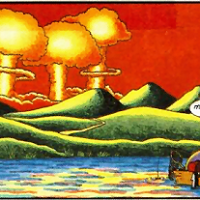 Here on the 4th day of the 4th month, I feel I really should be writing about the 4th dimension. I did say that I would during March Mathness, and I tried to set the math foundation here and here.
Here on the 4th day of the 4th month, I feel I really should be writing about the 4th dimension. I did say that I would during March Mathness, and I tried to set the math foundation here and here.
But two problems: Firstly, I’m kinda burned out. Those three posts were a bit of work, diagrams & models & math (oh, my!), and then trying to explain them clearly. Secondly, obviously no one finds this interesting except me, so not much motivation for the effort involved. Which was expected (kinda the story of my life). I also said these posts were as much recording my notes as attempts to share.
But it is 4/4 (and no Twins game today), so I thought I’d try winging it anyway.
As I’ve said, I have two goals:
Firstly, I want to understand tesseractae and the 4th dimension as much as possible.
Secondly, I want to understand what’s happening in this common “rotation” of a tesseract:
And I think I have achieved my second (lesser) goal. That’s the main thing I’ll try to explain today.
The first goal is still a work in progress, but progress I have, indeed, made. There is the challenge that, either 3D beings are (as one might expect) poorly equipped to fathom 4D, or is it possible more than three spatial dimensions isn’t a coherent idea in the first place?
§
It would make sense, as 3D beings, that we can’t make sense of 4D, but there are some indicators I perceive that make me wonder about the latter possibility.
For example, rotation is defined as points orbiting some axis, a perfectly sensible notion in 2D and 3D, but rotation in 4D requires (as we’ll see) rotation on two axes. (And in 2D, it’s arguable that it’s still a 3D notion.)
Perhaps it is rotation, not dimensions, that is strictly a 3D notion? (But what, if anything, does that suggest about higher dimensions?)
As an aside (within an aside!), physicists have established that there are only three “families” of matter, and there are other places where three is a magic number. Is it possible that 4D (and beyond) is pure mathematical invention?
Are 4D beings impossible, or is that just me being 3D provincial?
§
More to the point, could a tesseract actually exist or is it just a mathematical fancy?
One thing I found helpful in understanding a tesseract is an unfolded tesseract, which I call a “tesscross.” Here’s a (work-in-progress) video I made that unfolds a tesseract:
I’d like to do a bit more with this, but I’m still learning the ropes with the movie editor I have that allows titles and cross fades and all that fancy stuff. (Eventually it would be fun to start adding music!)
What this shows is, first, a tesseract, which is rotated on the Y axis, then the X axis, then the Z axis. All normal rotations in 3D space.
Then it unfolds the tesseract into a tesscross.
First the outer cube is peeled back. Notice how doing so reverses the direction of the X axis (the red lines). In this configuration, the outer cube is reversed. (Remember that; it’ll be important later.)
Next the eight “sweep” cubes — the ones that start off looking like square pyramids — expand into the full-sized cubes they actually are. Note the purple lines: that’s the W axis, the fourth dimension!
Finally, as the sweep cubes expand, so does the inner cube. It, too, was always a full-sized cube even though the typical tesseract figure shows it much smaller.
As the tesscross rotates, the two shaded cubes are the original inner and outer cubes. These are the only two of the four that are “normal” 3D cubes. That is, they have X, Y, & Z, dimensions.
The other six (non-shaded) cubes all have a w-axis and therefore lack one of the X, Y, or Z, dimensions. For instance, the top and bottom cubes have no Y axis (green). They are 3D cubes with X, Z, & W.
§
As a way of understanding the rotating tesseract, consider this rotating tesscross:
This is a test video I made a while back as part of my exploration. It was meant more to test the underlying mathematics than to create a pretty illustration. It has a severe issue I haven’t solved yet in how the end cubes behave (I’ll come back to that).
This video shows a single rotation mode, the first rotation mode shown in the tesseract video above (which shows three rotation modes).
There are two connections to grasp here:
Firstly, the connection between the cubes of the tesscross and those same cubes in the tesseract. The unfolding video is intended to illustrate that connection.
Secondly, the perhaps harder to grasp connection between the motion of the tesseract and that of the tesscross.
§

Inner cube
I think it helps to start with that inner cube.
In the tesscross, it slides to the right to become a side (sweep) cube. Meanwhile, the former side cube on the left slides right to become the inner cube.
This same motion occurs in the tesseract. The inner cube slides (and expands) to become a sweep cube, and the former sweep cube to its left shrinks and slides into its place.
But remember that all eight tesseract cubes are full-sized cubes with right angles!
[Incidentally, the six “sweep” cubes are called that because they are formed by sweeping a 3D cube through the W dimension to create the tesseract. See the post about tesseractae for details.]
I’ll come back to this sliding business in a moment, but for now consider the four cubes in the tesscross that spin in place.

Sweep cube (1 of 6)
There are the two on top and bottom. They spin on the Z axis (horizontal). There are also two side cubes (front and back) that spin on the Y axis (vertical).
Now locate the same four cubes in the rotating tesseract. It’s a little harder to spot, but you can tell they are just turning in place.
(That two spin on the Y axis and two others spin on the Z axis is exactly what I mean by 4D needing two axes of rotation.)
I already mentioned the top and bottom sweep cubes have X, Z, & W, dimensions (don’t ask Y). The front and back sweep cubes have X, Y, & W.
In contrast, the left and right sweep cubes — the two that partake in the sliding business — have Y, Z, & W. It’s probably hard to notice, but these two have a crucial distinction from the other four:
The left and right sweep cubes have only a W dimension, no X dimension. The other four all have both an X and a W.
Recall that the inner and outer cubes have X, Y, & Z. Importantly here, they have only an X dimension, no W dimension — the opposite of the left and right sweep cubes.
But in common, all four, the inner, the outer, and the left and right sweep cubes, all have either X or W, not both.
§
Why this is important:

Three of the moving cubes. The fourth is the outer cube.
The four cubes with both X and W rotate on their third axis, whatever it is (the Y axis or the Z axis). This is because, mathematically, the rotation involves the X & W axes.
That’s exactly like rotating a cube involving, for example, the X & Y axes (or X & Z, or Y & Z). The cube simply spins.
But when a cube lacks both the involved axes, it is rotated into another cube that also lacks one involved axis but has the opposing involved axis.
That is, a cube with only X (no W) is rotated into a cube with only W (no X). And vice versa, so as the X-only cubes are rotated out into W-only cubes, the W-only cubes are rotating into the X-only cubes.
That’s the horizontal movement, left to right, in the tesscross.
It’s also the horizontal movement in the first tesseract rotation mode (the other two are the same thing in the vertical and then front-to-back directions).
Important: The axes involved in the rotation are not the axis (or axes) about which points rotate. In the example discussed above, rotation is about the Y and Z axes. That rotation involves the X & W axes. Significantly, Y and Z values don’t change, but X and W values do.
§
 We can understand this in terms of a rotating cube.
We can understand this in terms of a rotating cube.
Imagine the cube is rotating on its vertical (Y) axis.
The top and bottom squares are just rotating about the Y axis. Those squares have only the X and Z dimensions. Since the rotation involves X & Z, the rotation is confined to the square.
All four side squares have a Y dimension, but either an X or a Z dimension.
So the two squares with only X rotate to the adjacent side where they replace their X values with Z values. Meanwhile, the two squares with only Z rotate into squares with X values.
In the tesseract, instead of sides rotating to the next side, cubes rotate to the next cube. (And, likewise, instead of squares rotating in place, cubes rotate in place.)
§
That’s kind of it; that’s the deal. Except for the weird 4D part.
Remember in the unfolding tesseract how the outer cube gets reversed? This is also related to how I mentioned my tesscross animation had a problem with the end cubes. Here’s another (slightly better-looking) version:
In the tesscross, the inner cube slides right to become a sweep cube. That sweep cube moves right to become the outer (reversed X axis!) cube.
And that right-most cube, the tesseract’s outer cube, slides right and… vanishes?
Meanwhile, kinda hard to see, the left-most cube, which slides right to become the inner cube, has a cube magically appearing from the left.
If you look closely at the corner labels, you’ll see that it’s the right-most “vanished” cube re-appearing on the left. This is mainly due to having unwrapped the tesseract.
In the tesseract, the right-hand sweep cube kinda folds out and back to become the outer cube. That folding back is the reversal of the X axis!
Meanwhile, the former outer cube folds left and in to become the left-hand sweep cube. That folding again reverses the X axis.
Basically, these four cubes are rotating from having only X to having only W, or vice versa. (It’s analogous to the four sides of a cube rotating from having only X to only Z.)
Meanwhile, the four spinning sweep cubes turn almost like bearings for the four moving cubes.
§
And that — other than the math — really is it.
Stay dimensional, my friends!













April 4th, 2019 at 5:16 pm
Asking as a lay person, isn’t all motion a manifestation of the fourth dimension?
April 4th, 2019 at 5:20 pm
Do you mean in terms of seeing the fourth dimension as time?
That’s Minkowski space. I’m pondering Euclidean space where the fourth dimension is a physical dimension at right angles to all three we know and love.
In a 4D world, time would be the fifth “dimension” (although I think calling time a dimension at all does it a disservice; one can move easily both ways in a dimension; one can also easily stand still 🙂 ).
April 4th, 2019 at 5:47 pm
Yeah, time never seemed to fit in with the others.
April 4th, 2019 at 6:08 pm
Yep. Even in Minkowski space, where it’s treated like a spacial dimension, it’s still different from the actual spacial dimensions — it gets subtracted from the spacetime interval.
April 4th, 2019 at 5:17 pm
(The problem with both those tesscross animations is that they’re missing a cube. There should be four in a line. The instant the right-most one starts to move, it wraps around and should appear at the left. I just haven’t solved the math of animating that yet.)
April 5th, 2019 at 6:27 am
You should write about this regardless of whether anyone reads this because it will make you feel better and you never know someone like me might come along and pay attention to your posts.
April 5th, 2019 at 9:52 am
You’re quite right; it did! And, right again, here you are! Welcome and thank you! (If you also liked my baseball posts, it would be a match made in heaven. 😀 )
As you say, one never knows, and it’s well worth trying. Many years ago a former co-worker contacted me because she wanted to buy me lunch and “catch up.” She was the Office Admin when I knew her, essentially a secretary, but I’d spent a lot of time with her teaching her how to use Lotus 1-2-3 (it was that long ago) and WordPerfect (very long ago). And I’d taught her a lot of things about her PC along the way. At lunch she told me my teaching had enabled her to go on to a position in IT where she’d done very well for herself. I’ll never forget that; best thing a teacher-type can ever hear!
So, yeah, voice in the wilderness not withstanding, tossing seeds always has potential value. You never know! 🙂
April 5th, 2019 at 11:52 am
I’m sorry I can’t help you out with the baseball posts. I like poker, ufc and basketball which are all American things purely because my husband likes them. Basketball is the easiest to talk about coz I do actually like that too.
April 6th, 2019 at 4:37 pm
Yeah, yeah, baseball never gets enough love! (Such a pity, because it’s the best sport (or at least the smartest sport, which makes it best in my book) and it is the truly quintessential American sport! 😀 )
So I take it you wouldn’t care at all that the Twins just beat the Phillies… 😉
April 6th, 2019 at 5:51 pm
No I wouldn’t and it’s because it’s quintessential American that I wouldn’t. I have been past the stadium in Boston and the World Series was on last time I was there and they were all super hyped.
April 6th, 2019 at 6:15 pm
I’m sure they were! The WS is the culmination of a summer of baseball! ⚾😍
April 6th, 2019 at 6:16 pm
I know and absolutely everything was about the baseball!
April 6th, 2019 at 6:21 pm
I’m hoping it might happen in my city this year! There’s a faint chance it could… 🤞
April 6th, 2019 at 6:24 pm
There always is be hopeful!
April 6th, 2019 at 7:39 pm
Heh, yep! No such thing as “false” hope!
August 6th, 2021 at 11:35 am
[…] is the rotation discussed in detail in the previous post. It’s the first rotation mode of the tesseract in the […]
January 17th, 2024 at 4:01 pm
[…] The 4th Dimension (87) […]